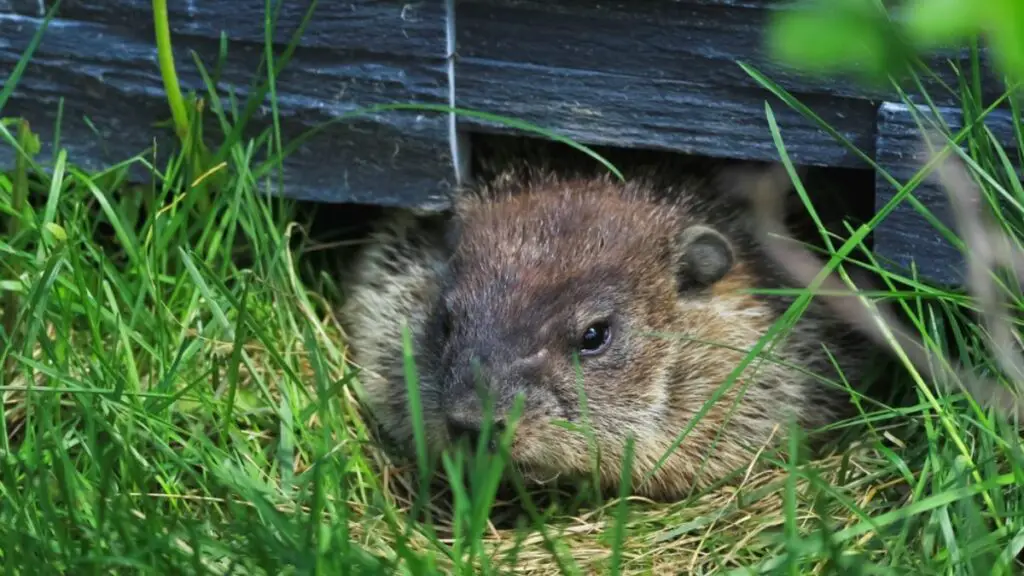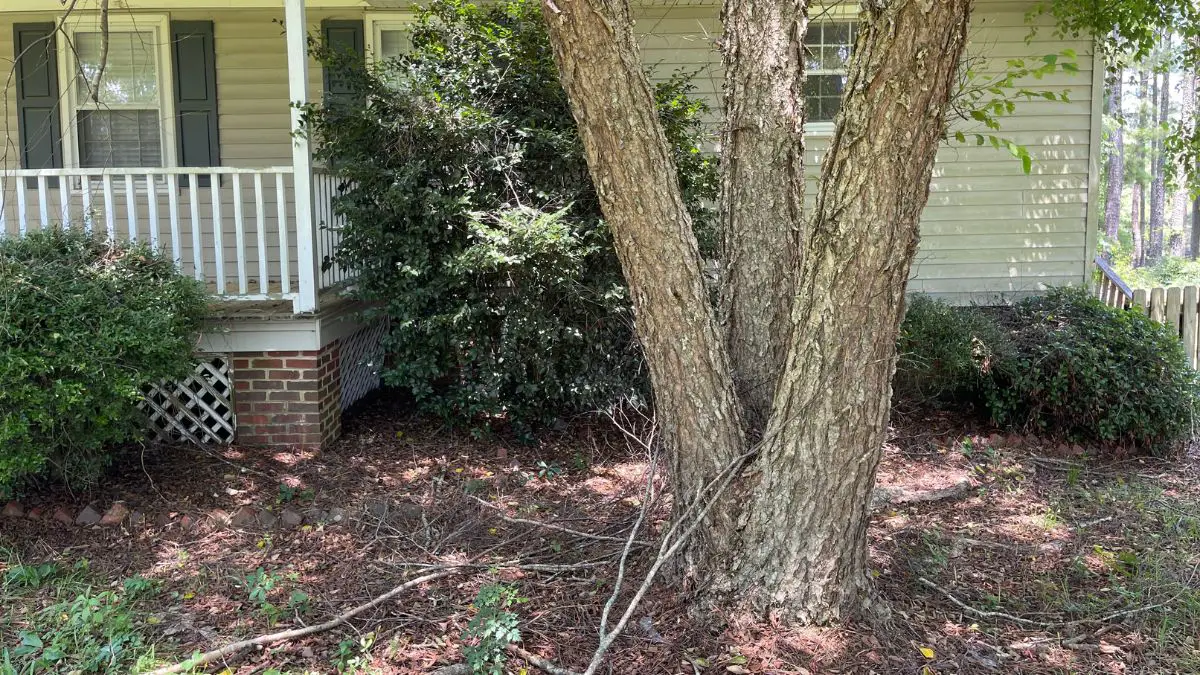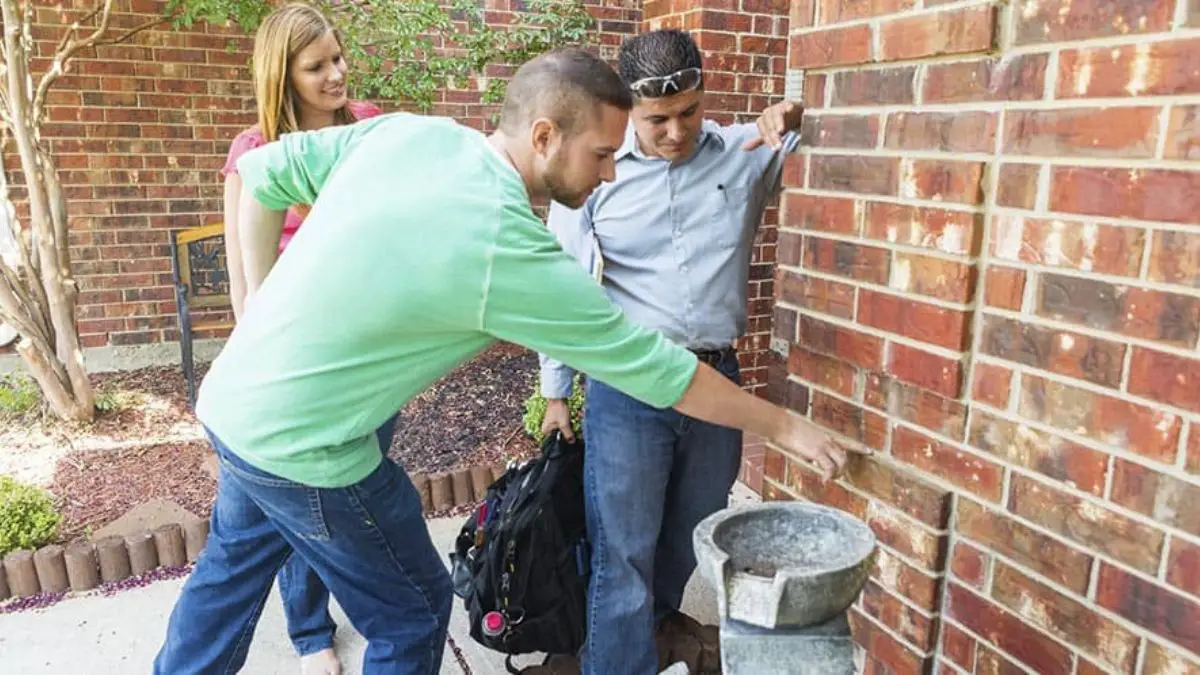Groundhog foundation damage occurs when these seemingly innocent creatures burrow beneath the surface, unknowingly compromising the foundation that holds your home or building together.
What may seem like harmless digging becomes a serious concern as it threatens the structural integrity of your property. It’s a problem that affects homeowners, property owners, and even business establishments alike.
While beneficial in their natural habitat, groundhogs’ burrowing behavior can cause significant damage to foundations when they inhabit areas near homes or buildings. Groundhog burrows can compromise the structural integrity of a foundation by creating voids beneath it.
Why does it matter? Well, the consequences can be dire. Left unchecked, groundhog foundation damage can lead to extensive and costly repairs, risking the safety of you and your loved ones.
So, whether you’re a vigilant homeowner, a concerned property owner, or simply someone who cares about the safety and longevity of buildings, this is essential information you can’t afford to ignore.
| Key Takeaways |
|---|
| Groundhog burrowing can cause significant damage to the foundations of homes and buildings. |
| Ignoring groundhog foundation damage can lead to safety hazards and structural instability. |
| Neglected foundation issues may make insurance companies hesitant to cover damages, leaving you liable for accidents or injuries. |
| Timely repairs prevent the issue from escalating into more severe problems, saving significant expenses in the long run. |
| Implementing preventive measures helps minimize the risk of further foundation damage from groundhogs. |
| Protecting your property and occupants from potential risks fosters a sense of security and well-being. |
| Groundhogs are rodents known for their burrowing abilities and extensive underground tunnel systems. |
| Groundhog burrowing can compromise the structural integrity of foundations and lead to cracks and other forms of damage. |
| Signs of groundhog activity include visible holes, groundhog sightings, garden foraging, and chew marks on wooden structures. |
| Groundhog foundation damage can result in structural problems, safety concerns, and costly repairs. |

The Basics of Groundhog Foundation Damage
Groundhogs, also known as woodchucks, are notorious for their burrowing behavior. They create elaborate underground tunnels and chambers as their homes and nesting sites.
Unfortunately, their burrowing can cause significant damage to the foundations of homes and buildings.
As groundhogs dig for food or shelter, they undermine the structural integrity of foundations by creating voids beneath them. Over time, this can lead to cracks in walls, windows, and doors becoming misaligned or sticking shut.
The Importance of Addressing Groundhog Foundation Damage
Ignoring groundhog foundation damage may seem like an easy solution in the short term, but it will not be a good option in the long run. Failing to address this issue could lead to more severe problems with your property’s structure.
5 Key Reasons To Address Groundhog Foundation Damage
- Safety and Structural Stability: Ignoring groundhog foundation damage can lead to structural issues like uneven floors, sagging walls, and potential collapses.
- Liability Concerns: Neglected foundation issues may make insurance companies hesitant to cover damages, leaving you liable for accidents or injuries resulting from the compromised structure.
- Cost-Effectiveness: Timely repairs prevent the issue from escalating into more severe problems that require expensive repairs or reconstruction, saving you significant expenses in the long run.
- Preventive Measures: Implementing preventive measures, such as monitoring and deterring groundhog activity, helps minimize the risk of further foundation damage.
- Peace of Mind: By protecting your property and occupants from potential risks, you can enjoy your home or building without worrying about structural integrity issues, fostering a sense of security and well-being.
Overview of Groundhogs
Groundhogs, scientifically called Marmota Monax and commonly known as woodchucks, are formidable rodents from the Sciuridae family. Native to North America, these industrious creatures are recognized for their remarkable burrowing abilities.
While their burrows may seem innocuous initially, they can pose a significant threat to properties, particularly their foundations. The persistent excavation of groundhogs can undermine the structural integrity of buildings, leading to costly damages and safety hazards.
Beyond their strong build and distinctive fur, groundhogs showcase remarkable burrowing skills, creating extensive underground burrows that span several meters.
These intricate tunnel systems provide shelter and protection and serve as nesting grounds for rearing their young. However, their burrowing endeavors can spell trouble for property owners.
Groundhog Tunnels: A Hidden Threat to Your Foundation’s Stability?
By tunneling beneath foundations, groundhogs weaken the stability of structures, potentially causing uneven floors, cracked walls, or even structural collapses. Such damages not only jeopardize the safety of occupants but also entail substantial repair costs.
Physical Characteristics and Behavior Patterns
Nuisance groundhogs, also known as woodchucks, can cause considerable and potentially dangerous damage with their deep tunnels and network of woodchuck burrows.
These nuisance animals can wreak havoc on your property, from damaging your vegetable garden and causing water damage to attracting other types of larger nuisance wildlife.
It is advisable to consult a wildlife or groundhog removal specialist and consider using groundhog repellent or installing chicken wire to prevent further damage from these persistent animals.
Groundhogs are known for their stocky build and short legs. They have long claws that they use for digging burrows and powerful jaws that can chew through wood and other tough materials. Additionally, they have thick fur that varies in color from reddish-brown to grayish-brown.
Have You Heard Yet?
Groundhogs are primarily active during the day, spending most of their time outside of their burrows searching for food or basking in the sun. They hibernate during the winter months, typically from October through February or March, depending on the climate.
One unique aspect of groundhog behavior is their ability to stand up on their hind legs. This posture is often used to survey their surroundings or defend themselves against predators.
Habitat Preferences
Groundhogs prefer open areas with plenty of vegetation, fields, pastures, and forests. They typically create elaborate networks and evidence of tunnels beneath the ground where they live and raise young.
Groundhog burrows can be extensive and may include multiple entrances and chambers. Burrows protect themselves from predators such as foxes, coyotes, and domestic pets. They also serve as a safe place for groundhogs to hibernate during winter.
Diet and Feeding Habits
Groundhogs are herbivores meaning that they feed exclusively on plant material such as leaves, grasses, fruits, and vegetables which can be problematic if you have gardens around your property.
They are known to eat various plants and can cause significant damage to crops. Groundhogs consume up to a third of their body weight in vegetation daily, which is why they can be so destructive.
Understanding groundhogs’ physical characteristics, behavior patterns, habitat preferences, and diet is important in preventing and addressing groundhog foundation damage caused by these wild animals.
Burrowing Behavior and its Effects on Foundations
Groundhogs are rodents known for burrowing into the ground for shelter and food and hibernating during winter.
Their burrows can be extensive, often spanning several feet underground and containing multiple chambers.
Over time, the weight of the building can cause the foundation to sink into these voids, resulting in cracks and other forms of structural damage.
A significant amount of soil displacement from their digging activity can also lead to erosion around the foundation’s perimeter.
Signs of Groundhog Activity Around a Property
There are several tell-tale signs to look out for to determine if groundhogs are present around your property, potentially causing foundation damage.
4 Key Signs to Watch Out For
- Visible Holes and Mounds of Dirt: One of the most common signs of groundhog activity is visible holes or dirt near your property’s foundation.
- Groundhog Sightings: If you observe a groundhog wandering around your yard or inside your home, it indicates its presence.
- Garden and Trash Can Foraging: Groundhogs are known for their scavenging behavior, particularly in gardens and near trash cans.
- Chew Marks on Wooden Structures: Groundhogs constantly need to gnaw on objects like wood or roots to prevent their teeth from overgrowing.
Identifying signs of woodchuck activity promptly is essential in taking proactive and additional measures to mitigate potential groundhog foundation damage.

Effects of Foundation Damage
The consequences extend beyond mere aesthetic concerns regarding groundhog foundation damage, including burrowing activity and groundhog holes.
The structural integrity of your buildings and homes can be significantly compromised, leading to many issues.
Structural Damage to Buildings and Homes
Groundhog foundation damage can cause major structural problems for buildings and homes. When groundhogs burrow underneath foundations, they undermine the stability of the structure.
This can lead to cracks in walls, uneven floors, and even collapses in extreme cases. Over time, the damage can become irreversible and require extensive repairs or complete foundation replacement.
The compromised foundation may also lead to moisture issues in basements or crawl spaces as water seeps through cracks created by groundhog activity.
This creates a damp environment that promotes mold growth and attracts other pests, such as termites or carpenter ants, further weakening the structure.
Safety Concerns for Occupants
Foundation damage caused by groundhogs can also create safety hazards for occupants of buildings or homes.
Uneven floors and stairs can cause trips and falls, leading to injury, while collapsing structures pose a more serious threat, such as entrapment or crushing injuries.
Compromised foundations may also affect indoor air quality as moisture from damaged areas leads to mold growth, posing health risks for occupants who suffer from allergies or respiratory conditions.
Costly Repairs and Maintenance
Repairing foundation damage caused by groundhog activity is costly and time-consuming. Depending on the extent of damage, repairs may require excavation around the perimeter of a building’s foundation, which is extremely labor-intensive work that requires heavy machinery.
Since homeowners insurance policies do not typically cover damages caused by pests like groundhogs, repair expenses fall solely on property owners’ shoulders, adding an unexpected financial burden.
Preventative measures such as installing physical barriers around foundations are effective but incur upfront costs. Similarly, professional pest control services are expensive but necessary when groundhog populations are too large, or damage is severe.
Note:
Ignoring groundhog foundation damage only leads to more extensive and costly repairs in the long run. Therefore, addressing the issue promptly is crucial for the safety and well-being of occupants and property owners alike.
Prevention Methods
Implementing preventive measures is essential to protect your property from groundhog-induced foundation damage. You can significantly reduce the risk of structural compromise by creating physical barriers that deter groundhogs from burrowing near foundations.
Physical Barriers to Deter Groundhogs from Burrowing Near Foundations
Preventing groundhog damage to the foundations of buildings can be achieved through the installation of physical barriers. These barriers are designed to discourage groundhogs from burrowing near the foundation of a home or building.
Consider the following points when installing physical barriers:
- Hardware Cloth: One reliable option is to use hardware cloth, a robust electric wire mesh material available in rolls at most hardware stores. Opt for high-quality hardware cloth that can withstand groundhog gnawing and burrowing attempts.
- Mesh Fencing: Mesh fencing is another effective choice for creating a physical barrier. Select a fencing material with a minimum 1-inch opening size, which will effectively deter groundhogs while still allowing proper airflow.
- Sheet Metal: Consider utilizing sheet metal as an additional physical barrier option. Attach it directly onto the foundation walls using screws or nails, creating an impenetrable barrier against groundhog burrowing attempts.
What You Need To Know?
During installation, it is crucial to dig a trench around the foundation perimeter and bury the physical barriers at least one foot deep. This ensures that groundhogs are unable to dig underneath the barrier and gain access to the foundation.
Trapping and Relocation Options for Humane Removal
If groundhog activity is already on your property, trapping and relocation may be necessary for humane removal.
Traps or food bait can be purchased at most hardware stores or rented from pest control services if you prefer not to handle them yourself.
Live traps are recommended as they allow you to capture and relocate without harming the animal. When setting up traps with food bait, placing them next to visible entrance holes near the foundation is important.
Baiting with fruits such as apples or vegetables like carrots will attract their attention more effectively than meat or other protein sources they don’t typically eat.
Check your trap regularly to relocate larger captured animals quickly before becoming distressed.
Professional Pest Control Services
If prevention methods fail or there are too many groundhogs on your property, it may be necessary to call a professional pest control service. They will have the knowledge and equipment necessary to handle the situation effectively.
Pest control services can also offer advice on preventing future groundhog damage by providing tips on landscaping, fencing, and other prevention methods.
What You Need To Consider?
It is important to choose a reputable pest control company that practices safe and humane trapping and relocation methods. Research different companies in your area before making a decision.
Humane Removal Methods
Some companies may use inhumane methods such as poison or extermination, which are cruel and illegal in some areas.
Physical barriers such as hardware cloth or sheet metal can be effective when installed correctly while trapping and relocation can be used to remove groundhogs already present safely.
If all else fails, contacting a professional pest control service is always an option for efficiently handling the situation while ensuring animal welfare.
Related Reading: Is Chipmunk Foundation Damage Real? Unveiling the Truth
Repairing Foundation Damage
If your property has experienced foundation damage caused by groundhogs, it’s crucial to take immediate action to restore structural integrity. Ignoring the considerable damage can lead to further complications and costly repairs.
Steps To Repairing Foundation Damage Caused By Groundhogs
A few steps must be taken to repair foundation damage caused by groundhogs properly.
- Assess the Extent of the Damage: Begin by thoroughly inspecting the affected area to determine the extent of the foundation damage.
- Consult with a Professional: For complex or severe foundation damage, it is recommended to consult with a professional foundation repair specialist.
- Implement Proper Drainage: Groundhog-induced foundation damage can be exacerbated by poor drainage around your property.
- Repair Cracks and Structural Issues: Depending on the severity of the damage, repair methods may vary. Small cracks can be filled with epoxy or polyurethane sealants to prevent further water intrusion.
- Address Groundhog Activity: While repairing the foundation damage, it’s crucial to address the underlying issue of groundhog activity.
- Monitor and Maintain: After completing the foundation repairs, continue to monitor the area for any signs of recurring groundhog activity or new foundation issues.
Importance Of Hiring A Professional Contractor For Repairs
While some may be tempted to repair their foundation themselves, a professional contractor must be hired for this work.
Benefits Of Hiring A Professional For Groundhog-Related Foundation Damage:
- Expertise: Professionals possess extensive experience working with different types of foundations and understand their unique reactions under various conditions, ensuring effective repairs.
- Compliance: Professional contractors are well-versed in local building codes and zoning regulations, guiding permits, inspections, and other requirements to ensure compliance.
- Comprehensive Warranties: Hiring a professional guarantees comprehensive warranties for their work, instilling confidence that the foundation repair has been executed correctly and will stand the test of time.
- Cost-Effectiveness: While there may be an upfront cost, investing in a professional ensures a thorough and reliable repair job, mitigating the risk of further damage or incomplete repairs in the long run
It is important to hire a professional contractor with experience with this type of work to ensure the repair lasts many years.
Groundhog Foundation Damage FAQs
How do I get rid of Groundhog under my foundation?
To get rid of a groundhog under your foundation, it is recommended to consult with a professional pest control service specialized in wildlife removal.
Can groundhogs chew through concrete?
Groundhogs are not capable of chewing through solid concrete. However, they can burrow near concrete structures and potentially cause damage to foundations by undermining the soil beneath them.
Are groundhogs bad to have around your house?
Groundhogs around your house can cause property damage, particularly to foundations, through their burrowing behavior. This can lead to compromised structural integrity and safety risks.
How long does it take a groundhog to dig a burrow?
Groundhogs can dig a burrow system with multiple chambers and entrances in a few days to a few weeks. The time taken depends on factors such as soil conditions and the complexity of the burrow.
Final Thoughts On Groundhog Foundation Damage
Groundhog foundation damage is a serious issue that can cause significant harm to both residential and commercial properties. It is important to address the problem as soon as it is detected to prevent further damage and avoid costly repairs.
Prevention is key when it comes to groundhog foundation damage. Installing physical barriers, such as wire mesh or fencing, around the perimeter of a property can help deter groundhogs from burrowing near foundations.
Trapping and relocating the animals is also an option for humane removal, but it should only be done by professionals trained in wildlife management. If foundation damage has already occurred, repairing it promptly is crucial.
A professional contractor should be hired to assess the extent of the damage and develop a repair plan. Delaying repairs can lead to more severe structural instability and more extensive and expensive repairs.








